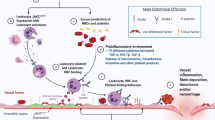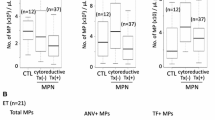Abstract
Thromboembolic events are frequent and serious complications of acute lymphoblastic leukaemia treatment. The importance of chemotherapy in the pathogenesis of this increased risk is enhanced by the fact that thrombosis rarely occurs at diagnosis. Our study aims at investigating the effect of chemotherapy on pro-coagulant activity (PCA), phosphatidylserine (PS) exposure, tissue factor (TF) activity and derived extracellular vesicles (EV) of Jurkat cells. Jurkat cells were treated with two commonly used chemotherapeutics: Vincristine (VCR) or Daunorubicin (DNR), at relevant concentrations. PCA of cells and derived EV were evaluated using Thrombin generation Assay (TGA). Cells or EV were incubated with annexin V or anti TF antibodies to assess the respective contribution of TF and PS. PS exposure on cells was analysed by flow cytometry. Derived EV were evaluated in fluorescence microscopy and flow cytometry. Untreated Jurkat cells and EV support thrombin generation. Thrombin generation was abolished when PS activity was inhibited by annexin V. VCR treatment resulted in a time dependent increase of thrombin generation. After VCR exposure, TF activity increased as well as PS exposure increased on the cell surface. The increase in TF activity was abolished by annexin V indicating that PS was required. A spontaneous release of EV from Jurkat cells was observed and VCR treatment increased the number of generated EV. Our results indicate that VCR increased the PCA of Jurkat cells predominantly through PS exposure and increased EV generation. Lymphoid blasts derived EV could be biomarkers to determine high thrombotic risk ALL patients.




Similar content being viewed by others
References
Caruso V, Iacoviello L, Di Castelnuovo A et al (2006) Thrombotic complications in childhood acute lymphoblastic leukemia: a meta-analysis of 17 prospective studies comprising 1752 pediatric patients. Blood 108:2216–2222. https://doi.org/10.1182/blood-2006-04-015511
Tuckuviene R, Ranta S, Albertsen BK et al (2016) Prospective study of thromboembolism in 1038 children with acute lymphoblastic leukemia: a Nordic Society of Pediatric Hematology and Oncology (NOPHO) study. J Thromb Haemost 14:485–494. https://doi.org/10.1111/jth.13236
Boissel N, Sender LS (2015) Best practices in adolescent and young adult patients with acute lymphoblastic leukemia: a focus on asparaginase. J Adolesc Young Adult Oncol 4:118–128. https://doi.org/10.1089/jayao.2015.0014
Mitchell L, Lambers M, Flege S et al (2010) Validation of a predictive model for identifying an increased risk for thromboembolism in children with acute lymphoblastic leukemia: results of a multicenter cohort study. Blood 115:4999–5004. https://doi.org/10.1182/blood-2010-01-263012
van Ommen CH, Chan AKC (2014) Supportive care in pediatric cancer: the road to prevention of thrombosis. Semin Thromb Hemost 40:371–381. https://doi.org/10.1055/s-0034-1370795
Grover SP, Mackman N (2018) Tissue factor: an essential mediator of hemostasis and trigger of thrombosis. Arterioscler Thromb Vasc Biol 38:709–725. https://doi.org/10.1161/ATVBAHA.117.309846
Bach RR (2006) Tissue factor encryption. Arterioscler Thromb Vasc Biol 26:456–461. https://doi.org/10.1161/01.ATV.0000202656.53964.04
Hathcock JJ, Rusinova E, Andree H, Nemerson Y (2006) Phospholipid surfaces regulate the delivery of substrate to tissue factor: VIIa and the removal of product. Blood Cells Mol Dis 36:194–198. https://doi.org/10.1016/j.bcmd.2005.12.032
Dong X, Shi J, Zhou J et al (2013) Chemotherapy induces enhanced procoagulant activity through phosphatidylserine exposure in acute lymphoblastic leukemia. Thromb Res 132:614–620. https://doi.org/10.1016/j.thromres.2013.09.010
Caruso S, Poon IKH (2018) Apoptotic cell-derived extracellular vesicles: more than just debris. Front Immunol 9:1486. https://doi.org/10.3389/fimmu.2018.01486
Thaler J, Ay C, Weinstabl H et al (2011) Circulating procoagulant microparticles in cancer patients. Ann Hematol 90:447–453. https://doi.org/10.1007/s00277-010-1111-1
Boles JC, Williams JC, Hollingsworth RM et al (2012) Anthracycline treatment of the human monocytic leukemia cell line THP-1 increases phosphatidylserine exposure and tissue factor activity. Thromb Res 129:197–203. https://doi.org/10.1016/j.thromres.2011.06.022
Gheldof D, Mullier F, Bailly N et al (2014) Microparticle bearing tissue factor: a link between promyelocytic cells and hypercoagulable state. Thromb Res 133:433–439. https://doi.org/10.1016/j.thromres.2013.11.008
Tsunaka M, Shinki H, Koyama T (2017) Cell-based evaluation of changes in coagulation activity induced by antineoplastic drugs for the treatment of acute myeloid leukemia. PLoS ONE 12:e0175765. https://doi.org/10.1371/journal.pone.0175765
Tzoran I, Rebibo-Sabbah A, Brenner B, Aharon A (2015) Disease dynamics in patients with acute myeloid leukemia: new biomarkers. Exp Hematol 43:936–943. https://doi.org/10.1016/j.exphem.2015.07.004
Van Aalderen MC, Trappenburg MC, Van Schilfgaarde M et al (2011) Procoagulant myeloblast-derived microparticles in AML patients: changes in numbers and thrombin generation potential during chemotherapy. J Thromb Haemost 9:223–226. https://doi.org/10.1111/j.1538-7836.2010.04133.x
Aharon A, Rebibo-Sabbah A, Tzoran I, Levin C (2014) Extracellular vesicles in hematological disorders. Rambam Maimonides Med J 5:e0032. https://doi.org/10.5041/RMMJ.10166
Casciola-Rosen L, Rosen A, Petri M, Schlissel M (1996) Surface blebs on apoptotic cells are sites of enhanced procoagulant activity: implications for coagulation events and antigenic spread in systemic lupus erythematosus. Proc Natl Acad Sci USA 93:1624–1629
Savaşan S, Büyükavci M, Buck S, Ravindranath Y (2004) Leukaemia/lymphoma cell microparticles in childhood mature B cell neoplasms. J Clin Pathol 57:651–653
Ullal AJ, Pisetsky DS (2010) The release of microparticles by Jurkat leukemia T cells treated with staurosporine and related kinase inhibitors to induce apoptosis. Apoptosis 15:586–596. https://doi.org/10.1007/s10495-010-0470-3
Cuccuini W, Poitevin S, Poitevin G et al (2010) Tissue factor up-regulation in proinflammatory conditions confers thrombin generation capacity to endothelial colony-forming cells without influencing non-coagulant properties in vitro. J Thromb Haemost 8:2042–2052. https://doi.org/10.1111/j.1538-7836.2010.03936.x
Hemker HC, Giesen P, AlDieri R et al (2002) The calibrated automated thrombogram (CAT): a universal routine test for hyper- and hypocoagulability. Pathophysiol Haemost Thromb 32:249–253. https://doi.org/10.1159/000073575
Besser M, Baglin C, Luddington R et al (2008) High rate of unprovoked recurrent venous thrombosis is associated with high thrombin-generating potential in a prospective cohort study. J Thromb Haemost 6:1720–1725. https://doi.org/10.1111/j.1538-7836.2008.03117.x
Machlus KR, Colby EA, Wu JR et al (2009) Effects of tissue factor, thrombomodulin and elevated clotting factor levels on thrombin generation in the calibrated automated thrombogram. Thromb Haemost 102:936–944. https://doi.org/10.1160/TH09-03-0180
Schneider P, Van Dreden P, Rousseau A et al (2010) Increased levels of tissue factor activity and procoagulant phospholipids during treatment of children with acute lymphoblastic leukaemia. Br J Haematol 148:582–592. https://doi.org/10.1111/j.1365-2141.2009.07958.x
Ansari SA, Pendurthi UR, Rao LVM (2019) Role of cell surface lipids and thiol-disulphide exchange pathways in regulating the encryption and decryption of tissue factor. Thromb Haemost. https://doi.org/10.1055/s-0039-1681102
Swystun LL, Shin LYY, Beaudin S, Liaw PC (2009) Chemotherapeutic agents doxorubicin and epirubicin induce a procoagulant phenotype on endothelial cells and blood monocytes. J Thromb Haemost 7:619–626. https://doi.org/10.1111/j.1538-7836.2009.03300.x
Kim S-H, Lim K-M, Noh J-Y et al (2011) Doxorubicin-induced platelet procoagulant activities: an important clue for chemotherapy-associated thrombosis. Toxicol Sci 124:215–224. https://doi.org/10.1093/toxsci/kfr222
Gheldof D, Mullier F, Chatelain B et al (2013) Inhibition of tissue factor pathway inhibitor increases the sensitivity of thrombin generation assay to procoagulant microvesicles. Blood Coagul Fibrinolysis 24:567–572. https://doi.org/10.1097/MBC.0b013e328360a56e
Spronk HMH, ten Cate H, van der Meijden PEJ (2014) Differential roles of tissue factor and phosphatidylserine in activation of coagulation. Thromb Res 133(Suppl 1):S54–56. https://doi.org/10.1016/j.thromres.2014.03.022
Larson MC, Woodliff JE, Hillery CA et al (2012) Phosphatidylethanolamine is externalized at the surface of microparticles. Biochim Biophys Acta 1821:1501–1507. https://doi.org/10.1016/j.bbalip.2012.08.017
Author information
Authors and Affiliations
Corresponding author
Ethics declarations
Conflicts of interest
The authors have no conflict of interest to disclose.
Additional information
Publisher's Note
Springer Nature remains neutral with regard to jurisdictional claims in published maps and institutional affiliations.
Electronic supplementary material
Below is the link to the electronic supplementary material.
Rights and permissions
About this article
Cite this article
Pluchart, C., Poitevin, G., Colinart-Thomas, M. et al. Vincristine induces procoagulant activity of the human lymphoblastic leukemia cell line Jurkat through the release of extracellular vesicles. J Thromb Thrombolysis 48, 195–202 (2019). https://doi.org/10.1007/s11239-019-01894-x
Published:
Issue Date:
DOI: https://doi.org/10.1007/s11239-019-01894-x




